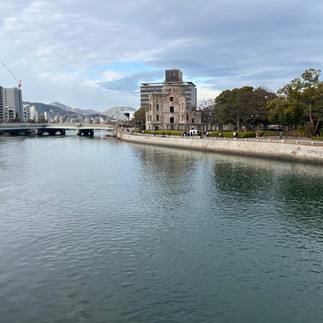Hiroshima: The City of Resilience
- emmaesocolich
- Feb 5, 2024
- 7 min read
Day 5- Himeji Castle and Hiroshima
The ONE THING I wanted to see while I was in Japan was Hiroshima. Ask anyone who knows me and they will tell you how much I love learning about World War II. Hiroshima was obviously a pivotal part of the war, and I knew there would be a fantastic museum to visit; I do love a good museum. Now, I am getting ahead of myself. First, we had to visit Himeji Castle.
Himeji Castle is the largest original castle still standing in all of Japan. The crisp white structure is a stunning sight to behold. The history behind the castle was absolutely fascinating to learn about. Quick pause while I geek out for a little bit. The first fortress built on the hill where the current castle stands was in 1333. A new keep was commissioned in 1581, and the construction of the current castle began in 1601 and was completed in 1609. The castle itself has never been destroyed or besieged, not even during the Second World War. How cool is that?! Furthermore, there was a princess that was one of the castle's most famous residents. Princess Sen married her first husband in 1603 at the age of six (her husband was only ten years old). He would die 12 years later at the old age of 22, leaving behind an 18 year old widow. She married again a year later and had 2 children with her husband before he, too, passed away at a young age. By all accounts, she was a noble ruler who mourned her lost husbands and son for the rest of her life. A deeply tragic yet beautiful story. (All the historical facts come from the historical concierge booklet I picked up at the site. I was the unofficial tour guide for my group).

Up close, the castle was breath taking. The traditional Japanese architecture was stunning to observe, and it was fascinating to locate the defense mechanisms put in place to protect the castle should any army try and take it by force, such as wooden window bars or holes in the walls meant for archers. Walking into the main keep, we were met with a woman demanding we take our shoes off. I did have to wear children sized slippers since the adult shoes were one size fits all (one size does not fit my size 5 feet). Shoes in hand, we set out on our mini tour of the castle. While there was no furniture left in the structure, I could almost imagine what it would have looked like. The rooms were vast spaces of dark wood and large windows. Ascending each floor meant a treacherous climb up the steepest steps imaginable (they were almost at a 90 degree angle), and I thanked whoever was watching over me that I chose small shoes instead of giant ones. One of the most memorable floors was the armory. Even though the sword and gun racks remained empty, I could feel the history present. How many soldiers had walked through that room preparing for a battle that would never come? Furthermore, my favorite room was on the top floor. At the highest peak, I could see all of the castle grounds as well as the city it was located in. Thank goodness it was a clear day!
Inside Himeji Castle
After taking our time walking through history, we made the perilous trek down the steps. I was gripping onto the railing for dear life. I refused to let my bum knee be my downfall. Once we were safely out of the castle, we took some time to walk around the main courtyard and observe the beautiful view. I think it was my favorite view of the entire trip (a big statement, I know!). Since we had another major site to visit that day, we did not get to explore the area as much as we would have liked. Sadly, it was time to head back to the train station to grab a quick bite to eat and begin the second half of our journey.
Himeji courtyard
Lunch was a simple meal of tonkatsu, fried pork with rice. Unfortunately, it took so long for the food to be cooked we had to doggy bag it and take it on the train with us. I had lost my appetite by that point, so it would become my dinner. I would later find the tonkatsu tastes much better when it is fresh instead of several hours after it was first prepared. No matter, though!
After a long, and emotional at times, day I was finally in Hiroshima. I would get to see my one thing! Since it was nearing 3pm, we set out for the Hiroshima Peace Memorial Museum. Immediately upon entering the museum, I was met with a clock indicating the days since Little Boy was dropped on Hiroshima (28,653) and the number of days since the last nuclear test (853). There was also a letter to President Joe Biden from the city of Hiroshima imploring him to immediately cease testing nuclear weaponry. This was especially poignant since the letter was dated in 2022.
The letter and clock
Walking into the exhibit portion of the museum, I was instantly emotional. I had not anticipated becoming emotional so early on, but alas, I could feel the tears brimming. The first stop of the exhibit was a series of photos showing the before and after of Hiroshima. This then led to a video reconstruction of what Hiroshima looked like through history up until the bomb was dropped. The minute I saw the cgi bomb falling and hitting the city center, the tears started falling. Needing to move on, I walked into the second part of the exhibit. This entailed reading a mixture of personal testaments from people on the day of the bomb as well as artistic interpretations of the bombing. More tears fell.
The most agonizing part of the museum was having to read about the child victims, and the majority of the museum was about the children who were victims. Early on, there was a graphic with about 20 pictures of children whose ages ranged from about 7 to 17 years old, and every single one of them perished in the bombing. I sobbed looking at every one of their faces. There was an especially brutal piece in the museum that has stuck with me all these weeks later, although every thing has remained with me. A rusty tricycle was on display that had once belonged to a 3 year old. He died in the bombing, and his father buried his body with the tricycle so he could ride it even in the afterlife. I really struggled with seeing this and reading the small excerpt that was supposed to represent his entire life story. How can you fully detail an entire person's life in only a paragraph or two? How is that fair? I cried the entire time I was in the museum. Each time the tears would begin to dry up, I would read another harrowing tale from the tragic day, and they would begin anew.
Another gut-wrenching story was that of Sadako Sasaki. Sadako was two years old when the bomb was dropped a mile from her home. She survived the initial tragedy and had a somewhat normal childhood until she developed leukemia at age twelve. Through her time in the hospital, she became fascinated with origami paper cranes. According to Japanese legend, cranes live for 1,000 years. Whoever folds 1,000 origami cranes for each year of a crane's life will have their wish granted. Sadako vowed to fold 1,000 of them for her wish of being healthy to come true. By the time she passed away, she had folded 1,300 cranes. There is a statue in the Peace Memorial Park dedicated to Sadako and the other children of Hiroshima who lost their lives either in the initial bombing or in the decades after.
I was an absolute emotional wreck by the time I reached the end of the museum. The pictures were incredibly graphic, the stories horrifically tragic, and yet the city recovered. The city rebuilt almost immediately after the bomb was dropped. All of Japan came together in their time of need. One of the biggest struggles I grappled with was my own history with Hiroshima. No, I technically had no involvement with the war seeing as how I was born in the 21st century, but I am an American. The museum, and city for that matter, did not seem to hold resentment towards the United Sates (at least that is my interpretation given the information provided in the museum). To me, the museum was more of a love letter to the victims, acknowledging their beautifully short lives and the painful last moments they shared with family and friends. The museum was a warning for what happens when the world becomes too obscured from reality. I am infinently grateful I visited the museum, but it is an experience I could really only do once.
Needing to remove myself from the absolute heartache I was feeling, I was led to the Peace Memorial Park. The park was a beautiful area to reflect on the harsh reality of warfare. There is a flame named the Flame of Peace that has been burning since 1964 in protest of nuclear warfare and will remain burning until there are no nuclear weapons in the world. I walked past the statue dedicated to Sadako Sasaki and almost immediately burst into tears yet again.
Peace Memorial Park
The final portion of the park was the A-bomb dome. This building was quite literally the epicenter of the bombing, and somehow the majority of it managed to remain standing. It was reinforced sometime in the 1960s so it could act as a reminder of what happened to the people of Hiroshima. The original bricks and debris still remain inside the building almost as if history has stood still in that small sector of the city.
A-bomb Dome
When all was said and done, I got to spend about an hour and a half in Hiroshima. I was disappointed that I did not have more time to explore the surrounding area, but maybe it was fate's way of telling me I had had enough for one day.













































Comments